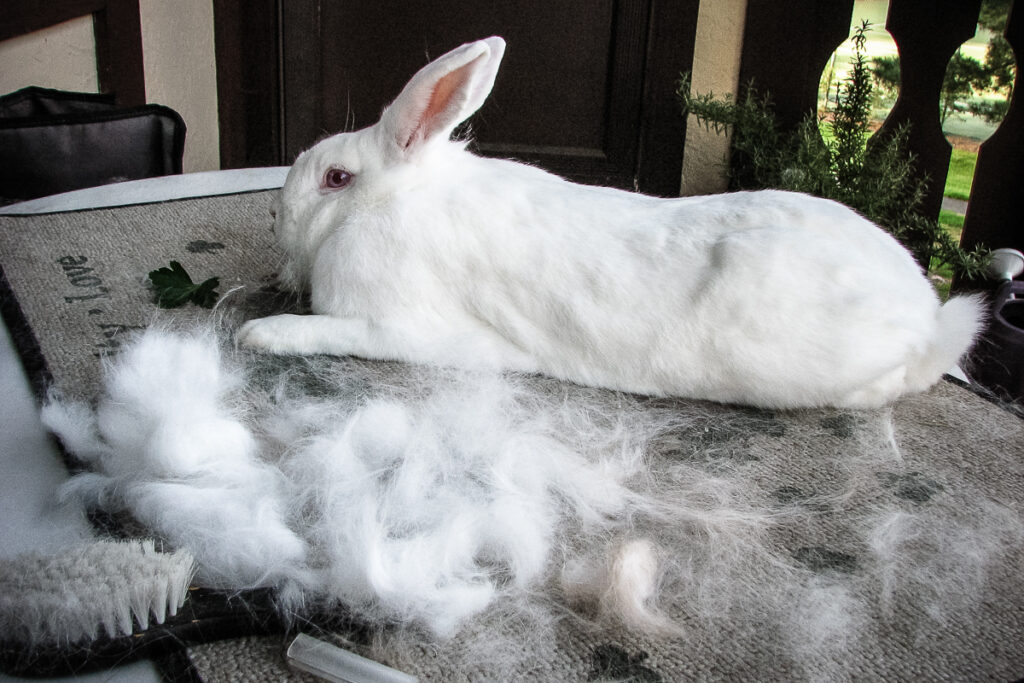The caller on the helpline is in tears. “My doctor says I’m allergic to my rabbit and I have to get rid of her. I love her so much. Can you find a good home for her?”
These calls are heartbreaking. It’s true that the easiest allergy treatment is to remove the triggering agent. But this ignores the importance of companion animals to our health and well-being. Our fosterers’ experiences show that allergy sufferers can live safely and happily with rabbits and other pets.
What Are Allergies?
Allergies are part of the body’s normal response to fighting infections. Sometimes the immune system becomes hyperstimulated and reacts to agents that normally are ignored. Common allergens include dust mites, cockroaches, and plant pollens. Allergies to animals are often caused by the saliva proteins left on the fur after licking and not the fur itself. Touching the fur transfers these proteins to our fingertips, and then to the face, eyes and nose. In turn, these entrances into our body are lined with immune cells ready to respond to any invaders.
For some people the proteins on rabbit fur are considered dangerous invaders, prompting the immune system to mount a full scale defense. Watery eyes and dripping nose try to wash away these proteins. The airway constricts in response to hormones such as histamines, which recruit more immune cells to the invasion site. This response is beneficial when the invader is influenza. A response to rabbits or other companion animals can instead cause misery and trouble. For several of our fos-terers, the inconvenience of allergies is far outweighed by love for our companions. Discussed here are strategies that HRS fosterers successfully use to minimize these discomforts.
What Am I Really Allergic To?
The first step is to determine whether you’re truly allergic to your rabbit. Physicians sometimes jump the gun in blaming an animal, and allergy tests can overestimate a person’s sensitivities. Use your best judgment and common sense. Be a detective. Rule out “suspected criminals” one by one. Is it bunnies or dust bunnies that make you sneeze? The hay tub with its pollen and dust? Frequent cleaning greatly reduces allergies.
Living with Rabbit Allergies
What if the worst happens and you’re allergic to your rabbit? The most important step is to minimize triggering those allergies. A few people may need to find their rabbit a new home; for severe asthmatics, a strong reaction can be life-threatening. For the majority of allergy sufferers, including several HRS fosterers, extra effort lets us share our homes for years to come.
Minimize direct contact. Never touch your face after handling your rabbit or items she contacts. Always wash hands (and don’t forget eyeglasses!) after visiting her. Have someone else clean her cage with the room’s door closed; if you must clean it, wear a mask and/or special clothes. Immediately remove soiled litter and hay from the house.
Restrict your rabbit’s territory. This reduces the spread of rabbit allergens in the house. Use baby gates to restrict her to certain rooms. This also makes cleaning easier.
Have rabbit-free rooms. Set aside at least one room in the home where the rabbit never visits, a safe area where the immune system isn’t stimulated. Your bedroom should be one of these rooms, because so much time is spent there.
Clean frequently! Dust and vacuum often, not just furniture but door frames, window ledges, lamps and curtains. Damp mop wooden floors, especially under beds and furniture. Reduce clutter. Keep hay in a tub, or try a different type of hay; some find misting the hay with water can be helpful in reducing dust. Store hay in a garage or location where you infrequently go. Many people find that their supposed rabbit allergy is actually caused by hay and dust mites.
Invest in air filtration units. The best are HEPA (high efficiency particulate air) filtration units, which pull microscopic dust, fur and other particles from the air. Although expensive, these filters are an excellent investment and improve the lives of many allergy sufferers. Minimally, run a HEPA filter full-time in your rabbit-free bedroom with the door closed; place additional units in other rooms, including the rabbit room. Central air systems with electrostatic filters are also helpful. Clean or change the filters regularly.
Try allergy neutralizers. Products such as “AllerPet” and “AllerPet/C” are liquids/sprays which are applied regularly to fur and neutralize some of the fur allergens. Shampoo formulations are not recommended as many rabbits are stressed by baths. These products work, but are expensive and must be used regularly. An alternative is daily brushing (preferably outside) and wiping fur with a damp cloth. These products are not substitutes for previous recommendations.
Seek allergy medication. Nasal sprays containing anti-inflammatory steroids are excellent for controlling severe allergies. These drugs suppress the local immune system in eyes and nose before the allergy is triggered. Others have good success with allergy desensitization shots; ask whether you can use your rabbit’s own fur. For myself, regular use of nasal steroid sprays almost completely suppressed my allergies to pollen, guinea pigs and cats; now I need it rarely. Consult a sympathetic doctor and find products that work for you.
It’s true that these suggestions require effort. Given our rabbits’ unconditional love, it’s the least we can do in return.

